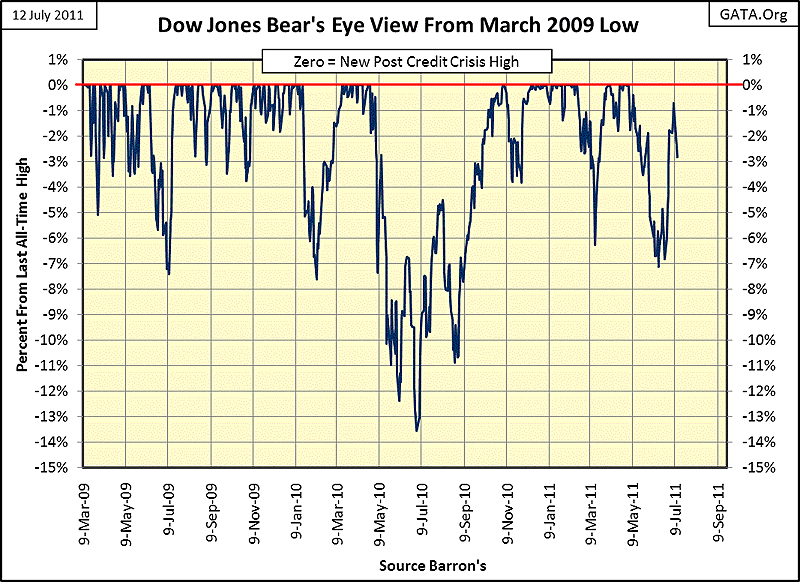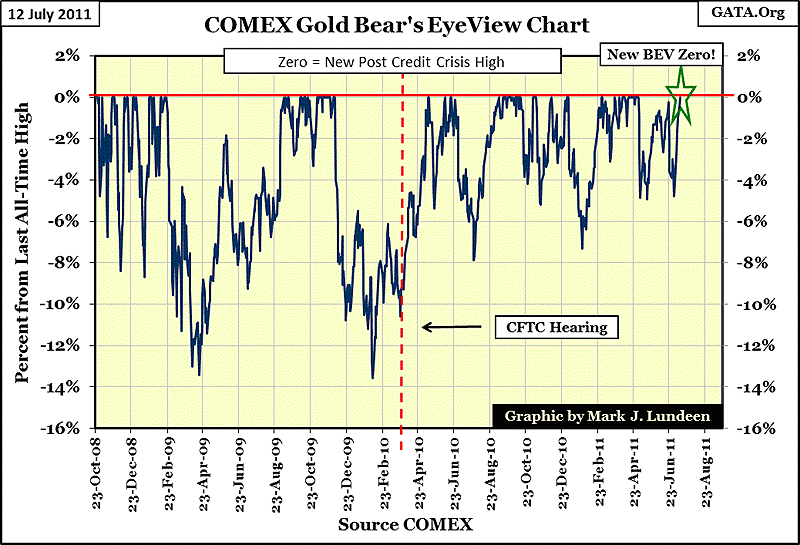Decoupling The Stock Market From The Price Of Gold
Traditionally, the long-term trends in the stock market and gold are counter-cyclical to each other. But there are those periods of market history where the Dow Jones and gold rise and fall with each other. Since 2001, when the bull market in gold began, the stock market and gold have frequently trended up and down together. But this is an anomaly in the inflationary cycle; because what is good for one is bad for the other. The day is coming when gold's price trends will decouple from the Dow Jones; beginning a new era where rising gold prices will produce new lows in the Dow Jones, as wealth flows from financial assets, into gold and silver.
Looking at markets with the Bear's Eye View (BEV) we are observing bull and bear markets from a perspective of running series of new highs, and price corrections from new highs. Each new high on a BEV plot registers a 0% (BEV Zero). All data-points not a new high are converted into a negative percentage from its last high. If one wants to know how far an index exceeded one previous high to the next, they won't see it in the BEV charts below. A price chart must be used for that sort of information.
What we do see in the BEV plot below is since the Dow's 09 March 2009, -53% bottom, it has laid out a nice bullish BEV pattern. Lots of BEV Zeros, with 5 price corrections. Four small corrections of less than 8%, and only one correction of more than 10%. This is a nice bullish pattern!
Like gold and silver, the Dow also began its latest correction on the first day of May, taking the Dow down 7% from its 29 April's Terminal Zero (TG = last new high before the 7% correction). From the correction's low of 15 June, the Dow increased to just 0.71% of making a new post credit crisis high, or new BEV Zero in the chart below. But over the weekend, the market got some bad news from Europe, and by the close of Tuesday, we see that Mr Bear clawed back over 2% of the Dow's gains from June.

But the Dow just days ago, was only 0.71% away from making a new post-credit crisis high. Why didn't the stock-market bulls pick up this low lying fruit in the market? Because news of a developing credit crisis in Europe spooked them. Since last Thursday, the Dow Jones has seen three successive down days. On Tuesday's close, the Dow found itself 2.84% from making a new BEV Zero. Now the bulls may yet get another BEV Zero. But the point I'm making is that on bad news in the sovereign debt markets from Europe, the bulls in the stock market blinked!
Gold from its Credit Crisis lows has also performed very well. Not as many new highs (BEV Zeros) as the Dow, but since October 2008, gold has been advancing! We can't see how well gold has actually done in its BEV charts below, but since 11 September 2009, each BEV Zero below was actually a NEW ALL-TIME HIGH in the price of gold. Compare gold to the Dow Jones; since the Dow's March 2009 lows (three years of trying), this is something it has failed to do.
This failure of the Dow to exceeding its October 2007 highs is a sign of weakness in the stock market. I'd call it a waving RED FLAG! What the heck, since January the Dow has been within 15% of making a new all-time high. That's not much of a climb. What is the Dow waiting for?
Bad news from Europe may have caused the stock bulls reconsider their positions in the Dow Jones, but on the other hand, gold was buoyed by news of massive pending defaults. Gold has closed higher every day for the past six trading sessions, and saw a new all-time high today (12 July). I placed a green star over gold's last BEV Zero on the BEV chart below.

My ability to peer into the future is no better than anyone else's, but I've a seeker of nuance in the markets for a long time. Frequently, things happen that at the time seemed unimportant, but in the fullness of time prove to be huge turning points in the market. Since the lows of the credit crisis, the Dow and the price of gold have in the main, advanced and declined together. But historically, their long term trends are counter-cyclical to each other. It's not hard understanding why this is so: financial assets rise as "liquidity injections" from central banks inflate a bubble in their valuation. Gold underperforms during financial asset bull markets, as people abandon traditional hard assets for the double digit inflationary capital gains available in financial assets.
But the inflationary gains in financial assets (like we have) can only be maintained to the point where debtors' (countries, businesses, and citizens) income can service the credit their central banking system has extend to them. So, massive financial bubbles are supported by the economy's ability to service its inflationary debts. The end-point of the bubble comes when debt service exceeds a critical threshold percentage of the income, wages or tax receipts of the debtors.
The economy begins a long slide into depression. Rolling defaults run across the globe, destroying wealth as far as the eye can see, and interest rates begin to soar to levels not believed possible just a few years before. Interest rates don't rise because a bearded weasel at the Fed decides to raise them, but because the markets begin dumping bonds like hot potatoes, and the stock market follows bonds in the deflationary downdraft. In an economy in collapse, "safe harbor assets" like US Treasury debt, or hot investments like Apple Computer and social networking stocks lose their appeal. But gold and silver, assets with no counter-party risk, come into their own!
Since the credit crisis lows of a few years ago, we've seen a good bounce in financial assets, as well in gold and silver. But the bounce in financial assets is only a post March 2009 dead-cat bounce. The true bull market primary trend is in gold and silver, and has been since 2001! On Tuesday, 12 July, gold bravely made a new all-time high, as the Dow Jones retreated on fears of European sovereign debt default. This just might prove to be the first day of a new market reality: rising interest rates punishing investors in fixed income and common stocks, while precious metals becoming the asset class of choice for refugees from the bond and stock markets. Note to CNBC "gold experts": gold and silver investors will learn to love double digit interest rates!
[email protected]
















